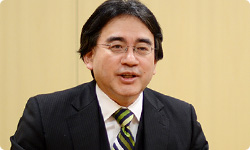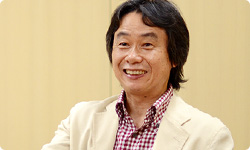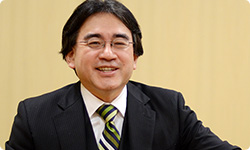4. The Enjoyment of Turning 2D to 3D
As I talked with the original staff of Ocarina of Time over the course of two conversations, I kept wondering why they have such a good time talking about it. I sensed that perhaps they enjoyed seeing the game improve each day.
Yes.
And talking with you today, I learned that within a short period of time, you discovered a lot of new things. It was a concentrated period of successive discoveries where you thought, “Oh, I see!” and “Oh, I just need to do it like this!”

That’s why every day was fun.
When each day brings new discoveries and they’re highly concentrated like that, it is fun for the person making it, no matter how physically demanding it is or how long you have to work.
That’s right. On the other hand, it isn’t always fun when you’re deftly turning out a game using methods you’re used to.
Right.
When you change something from 2D to 3D, though, you discover a lot of things, like certain things become no fun anymore. For example, cutting the grass was something that first appeared in The Legend of Zelda series with The Legend of Zelda: A Link to the Past.13 When we made it, it was surprisingly fun. Some people started talking about how this was a video game in which you cut grass using Spin Attack! (laughs) 13The Legend of Zelda: A Link to the Past: An action-adventure game released for the Super Famicom system in Japan in November 1991.
(laughs)
But when we went to bring that element of cutting grass into The Legend of Zelda: Ocarina of Time, it was like we were under orders to do so.
It’s not like you could be certain that when you changed cutting grass into 3D it would be even more fun.
Exactly. Just when we were saying that simply remaking that old topic in a prettier way wasn’t particularly impressive, we started talking about how it was weird that you could cut the grass but couldn’t cut the signs.
So you asked SRD’s Morita-san to take care of that. He told me about it. (laughs)
You heard? (laughs) We became able to cut the signs, but then we knew people would cut them in different directions. When I said that the signs should cut diagonally when Link swings diagonally, everyone froze up and said, “We can’t check exactly where they cut it!”
You wanted the signs to cut exactly where you struck them?
Even with the Nintendo 64 system, that would be impossible. So I said, “No, we just have to make several different cut patterns.”
Then you made it cut into six pieces like a wheel of cheese.
Right. Then you could cut the signs from different directions, but then when a piece flew off and landed in the pond, since we hadn’t taken care of collision detection when it hit against water, it would just fall to the bottom with a clack.
It would be weird if it clacked against water.
Generally, you would just decide not to put a sign by the water, but Morita-san made it so the piece would float on the water.
And it drifts away.
Yeah. Morita-san made that because he was certain the players would love it. Then we just wanted to put more signs by the water!
Haruhana-san described that as hospitality that attacks.
Oh...
In other words, the game is very hospitable, but with a certain roughness. That hospitality is everywhere, waiting anxiously for someone to enter so it can pounce!
Like in a haunted mansion.
Right. It attacks like in a haunted mansion. (laughs)
I think “hospitality” is the right word, too. For example, we had used the idea of grabbing onto a chicken and flying with the game on the Super Famicom system. I thought it would be weird if the graphics were more realistic, but when we made it, I was happy to see that it fit perfectly. I realised that those kinds of things are more fun in a 3D space, so all of a sudden I said, “Let’s make the landforms more three-dimensional.”
You changed the landforms for chicken-flying.
Then about that time, whichever village I saw, I thought it was rather bleak and boring. I started referencing villages in mountainous districts in China such as you might see in a documentary television show. I was saying, “See? There are all kinds of villages!” and “Can’t we make a more distinctive village?” And just then, it connected perfectly to the chickens.

You changed the villages to have more slopes so it would feel better to fly with the chickens.
Yes. That too was a kind of hospitality. After changing the villages, we kept on in that spirit and reworked Zora’s River so it would have more rise and fall.
Once you took care of one thing, you found something else to do.
Right. Originally, the only thing written in the specifications about Zora’s River was “Make it a landform like you don’t usually see.” (laughs)
That’s pretty vague! (laughs)
But that was enough for (Makoto) Miyanaga-san and others, who were in charge of landforms. You could just say, “Let’s make a distinctive village,” or “Let’s make a really castley castle.” (laughs)
(laughs)
For Zora’s River, it was “Make it a landform like you don’t usually see.” But real nature is pretty spectacular. Lots of real landforms far surpass human imagination, so ours can’t really compete.
I suppose not.
When you fly up north in an aeroplane...
Like when going to Europe.
Like maybe from Europe to America? When you look down from a point near the Arctic Circle, you see lots of strange landforms that make you want to go down and take a look around.
But if you did, it would probably be a really harsh place. (laughs)
Yes. If you went there, you’d never come back! (laughs) When I see places like that, I realise how limited human thought is. Even if we made something really unusual with polygons, for some reason it would still look like landscape scenery that you would see in real life. Making stuff like that each day was incredibly enjoyable.
More concentrated discoveries.
That’s right. When we were making The Legend of Zelda: Ocarina of Time, we poured our energy into new things.
It is moving when you see someone put forth so much effort.
Yes. But to those of us making the game, we kept thinking right up to the very end how this, that and the other thing weren’t good enough yet. For example, there’s the Gossip Stone where you can hear hints and rumours. If you put a bomb next to it...
It flies off like a rocket. When I first saw that, I was stunned. (laughs)
We put that in toward the end. We put so many Gossip Stones around the place that we began running out of lines for them to say, so I said, “Just have them tell the time.” (laughs)
(laughs)
It was sort of like saying, “Wrong stone. Better luck next time.” (laughs)
Yeah, like “Try again.” (laughs)
Like that, right up until the very end, we were saying, “It’s missing something,” and “Is this really good enough?”
I suppose that’s how all that hospitality on the attack entered the game.

I think so!